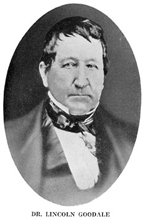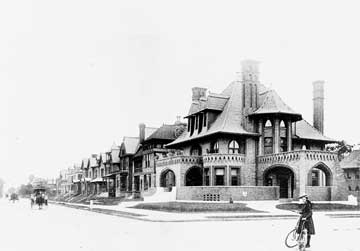
Columbus, Ohio USA
RETURN TO HOMEPAGE www.shortnorth.com
The Short North That Was
Dr. Lincoln Goodale and His Living Legacy
Part Eight
July 2007 Issue
by Beverly Mullet Randall
email info@shortnorth.com
The 1950s and 1960s – A Toned-Down Era for Goodale Park
© Photos courtesy of the Columbus Metropolitan Library, Division of Biography, History & Travel
Dr. Lincoln Goodale The early 1950s marked another era of change for Goodale Park – one that seems to have been more about toning down and leveling off the excitement, activity and plans of the previous years. Over 100 years had passed since the land was deeded to Columbus as a pleasure ground and the concept of what that entailed was shifting again. According to local historian Terry Sherburn, the idea that parks should provide beautiful, wooded, scenic places for adults was gradually turning to the definition of parks as playing fields and open grassy areas for children.
Management issues were also afoot. Dr. Goodale’s donation of the land in 1851 had required that a separate committee be established to manage Goodale Park. Sherburn says this stipulation created a problem for Columbus in creating a unified, citywide park plan, and because of this, Goodale Park was managed differently from the other parks. Even though the Goodale Park Committee continued into the 1960s, from the 1930s on, Sherburn said serving on it was probably just an honorary position. The only record he has been able to find for any actions taken by this committee since the ‘30s was a letter in 1954 stating the committee’s position that they did not think the second lake should be removed. The letter seems to have had little effect: In January 1954, the city filled in most of the second lake to create the baseball diamond. “A lot of administrative people didn’t like that lake – it was a maintenance problem with weeds and algae,” says Sherburn. He adds that the City Council never did formally abolish the Goodale Park Committee; they just stopped appointing people to it.
Later in 1954 and 1955, the carriage drives were covered over. In 1964, the city surfaced a parking lot that was in the location of part of what had been the second lake. Once again, the issue of the original deed came into play that said the land would revert to Dr. Goodale’s heirs if the land was used for anything other than park use. It was determined that this was still a legal use of the land since the lot would only be used when the park was open. In 1969, the water for what remained of the second lake was quietly turned off; the lake was drained and filled in and the present-day tennis courts were constructed on the site.
The urban renewal project era of the late ‘50s and ‘60s brought more changes to the park and nearby neighborhoods. The demolition of much of neighboring Flytown’s housing meant a lot less people were in the area to use the park. Urban renewal also provided some funds for the park, although there seems to have been some problems in using those funds. In July 1964, a local newspaper reported that federal regulations had forced the city to buy trees from an outside source for the Goodale Urban Renewal project rather than use trees grown locally by the city park division. The city paid $8600 for 385 trees planted in mid-May. It was estimated that 70 had died by July and would need to be replanted.The 1970s and 1980s: Restoration Efforts Struggle with Dangerous Crime for Control of Goodale Park
Another administrative change affecting Goodale Park occurred in the 1970s when the city recreation director Mel Dodge brought the two separate departments of Parks and Recreation into one department. In 1972 and 1973 the new Parks and Recreation Department significantly refurbished Goodale Park by reconstructing the pond and installing new walks and park benches around the water. At this time the park facilities included a playground, shelter, swings, slides, a softball diamond, tennis courts and picnic tables. Plans were underway to refurbish the playground equipment by the end of June 1973.
This 1897 view of Dennison Avenue shows the home of circus man Peter Sells in the foreground who designed it to look like a big-top circus tent. This home and other nearby Victorian-age mansions feature portals, towers, bay windows, large verandas and steep roofs. Many of these structures remain intact today with few exterior changes, making the area around Goodale Park a historical district. During this time, there was a citizens group called the Goodale Park Restoration Committee. This committee provided the city with a list of recommendations for improving the park, including the hiring of a fulltime caretaker to live in the unoccupied brick house in the center of the park. (In the early years of the park, the caretaker had lived in the park.) The committee said that the park needed policing because of the many transients who slept in the park. They were told there was no money for a fulltime caretaker. In addition to making recommendations for improvement, the committee also scheduled several Sunday and holiday band concerts.
In 1973, the Goodale Park area was cited for designation as a historic area because of the nearby Victorian-age mansions with their porte-cocheres, towers, bay windows, large verandas, arches, and steep roofs. Many of these homes had been converted to uses other than residences but had retained their architectural integrity, qualifying them as historic structures. For example, in the 1970s, circus man Peter Sells’ former residence on Dennison Avenue was occupied by the Castle Park Kindergarten, and the Baby Bunting Nursery was in the carriage house. The former William Fish residence, also on Dennison, had been converted to apartments and its carriage house was a single-family residence.
Goodale Park’s Shelter House also received a makeover in 1974 along with a number of other city park shelter houses. The Parks and Recreation Committee appropriated $1,400 for project plans and $40,000 for the entire renovation which would include repairing the building’s heating and plumbing systems and enclosing the open end of the shelter house so that it could be used year-round for meetings and other community events.
In spite of these efforts though, crime was a serious problem in and around the park. In 1975, a 21-year-old Thurber Village woman was walking to her boyfriend’s house at about 3 a.m. when three men attacked her and dragged her into the park where she was beaten, raped, and robbed of about $10. A year later a 68-year old man was found bludgeoned to death behind a garage nearby. The suspects in this crime led police to believe some of the man’s personal belongings might be in the Goodale Park pond. Evidence, believed by some to be the man’s wristwatch, linking the suspects to the murder-robbery was found when police had drained the pond.
Another brutal crime occurred in the summer of 1980. Police arrested three men for beating and robbing an 81-year-old man as he sat beside the Goodale Park pond at 3:45 in the afternoon. The three men had demanded the man’s money and when he refused to give it to them, they began hitting and kicking him, cutting his head, face and upper body, savagely beating him and leaving him in a pool of blood. Three other elderly men in the park witnessed the crime and reported it to the police who cruised the neighborhood and found three men matching the suspect’s descriptions buying groceries at the Neil Avenue Big Bear store. The police took the witnesses to the store where they identified the suspects who were then charged with the crime. The men had robbed the victim of $22.50, a Timex wristwatch, his wallet, and his belt.
Special thanks to local historian Terry Sherburn.
©2007 Short North Gazette, Columbus, Ohio. All rights reserved.

